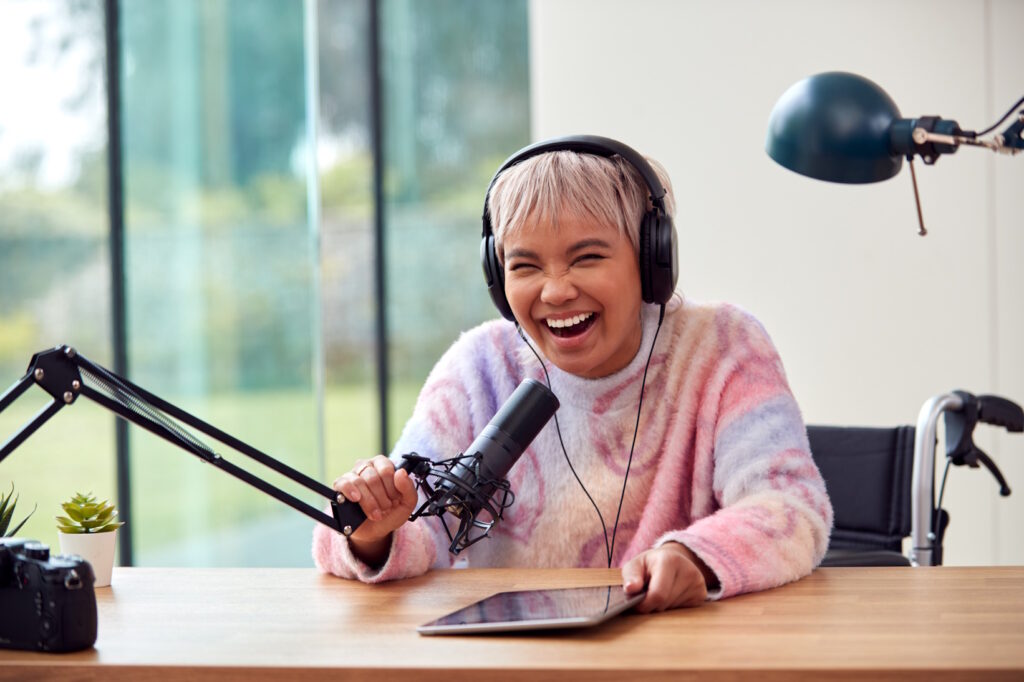
Effective Podcast Engagement Strategies are vital to ensure the success of your podcast. Engaging with your listeners is the key to a thriving podcast. It’s what distinguishes a successful podcast from an average one. Audience engagement helps in the continuous growth of a podcast and transforms passive listeners into a dedicated and loyal community. It forms the backbone of your show’s ecosystem.
A listener decides within the first few minutes whether your podcast is worth their time. As a podcast host, your challenge is to grab their initial attention and keep them engaged every 2-5 minutes. For instance, you could introduce a new topic related to the latest tech trends, ask a thought-provoking question about the impact of AI on jobs, or share an interesting anecdote about a famous entrepreneur to combat the risk of losing their attention.
This introduction starts with discussing various strategies to engage your audience. We’ll explore the art of captivating your listeners, the structure of content that keeps them engaged, and the interactive strategies that turn listeners into active participants.
Remember, your podcast is unique, and the way you engage your audience is the melody that will either resonate memorably or fade into silence. So, let’s dive together into the dynamics of audience engagement and transform your podcast into an auditory experience that resonates, engages, and endures.
Understanding Audience Engagement in Podcasting
Audience engagement in podcasting transcends the mere accumulation of listeners; it represents the active and dynamic interaction between the podcaster and their audience. It’s the magnetic pull that not only attracts listeners to your content but keeps them returning, episode after episode. This level of engagement is measured not by the passive action of hitting the play button but by the active behaviors that follow: the listener’s focused attention, emotional investment, and interactive responses.
Engagement is the bridge between passive consumption and active participation. When a listener pauses to reflect on a question posed by the host, when they laugh out loud at a joke, or when they follow through on a call-to-action, they are engaged. This kind of involvement turns a one-time listener into a loyal fan. It is also the kind that prompts them to share the podcast with others, expanding its reach organically.
The engaged listener does not simply absorb content; they experience it. They may send a tweet about the episode, leave a review, or join a discussion forum. They anticipate new releases, often becoming advocates and promoters of the content they love. These behaviors are the lifeblood of a successful podcast, as they indicate a deep connection beyond casual listening. They signal that the content is resonating, sparking thought, evoking emotion, and encouraging interaction.
In the context of podcasting, engagement also involves anticipation. When listeners anticipate new episodes, it signifies a shift from casual interest to committed listening. They might set reminders for new releases, subscribe for updates, or discuss previous episodes with friends. This anticipation builds a community around the podcast, creating a shared space for listeners to convene and connect, not just with the content but with each other.
Actual engagement in podcasting, therefore, is a holistic measure of how content resonates with listeners and incites action. It’s about creating a podcast that doesn’t just speak to an audience but speaks with them, fostering a sense of community and belonging around shared stories and experiences.

The Hook: Captivating Listeners from the Start
The opening moments of a podcast are a golden opportunity to secure the listener’s attention – they are the crucial window in which a strong hook must be cast. Crafting this hook is a deliberate exercise in creativity and strategy, one that leverages the best practices of storytelling to ensnare the listener’s curiosity from the outset.
A compelling hook often starts with a story or question that is both relevant and intriguing. For instance, opening with a personal anecdote that ties into the more prominent theme of the episode can create immediate rapport and set the stage for what’s to come. This story doesn’t need to be overly detailed; it simply needs to be evocative enough to draw the listener into the episode’s world. The hook could also be a provocative question that challenges the listener’s preconceptions, urging them to listen for insights or revelations.
The strength of a hook lies in its relatability and the promise it holds. Whether it’s a startling statistic, a surprising fact, or a dynamic narrative moment, a good hook hints at more depth, inviting the listener to dive into a sea of discovery. It’s about presenting a puzzle that the episode will help solve or revealing a piece of information that raises questions, ensuring the listener stays tuned for answers.
Moreover, the hook should resonate with the target audience’s interests or experiences, tapping into their emotions or intellect. It might leverage the universal appeal of conflict, mystery, or triumph or offer an unexpected insight that piques intellectual interest. It should be delivered with an energy and passion that mirrors the following content, setting the tone for the entire episode.
Creating a solid hook also involves pacing. It should arrive early in the podcast, ideally in the first few minutes, when the listener decides whether to commit their time to the episode. This means the hook should be crafted as a concise and impactful statement or narrative that can be quickly absorbed and appreciated.
Incorporating a narrative hook effectively requires a balance of information and suspense. Provide enough detail to intrigue but not so much that the listener doesn’t feel compelled to continue. It’s the art of revealing just enough to whet the appetite, leaving the listener eager for the entire meal of your episode’s content.
A hook is an opening line and a strategic lure that draws listeners more deeply into the podcast. It’s the initial note in a symphony that hints at the richness of the composition to follow. By mastering the art of the hook, podcasters can transform passive listeners into active participants eager to embark on the auditory journey they have crafted.
Content Structuring for Maximum Engagement
Creating a podcast that maintains listener interest requires more than just compelling content; it demands a strategic approach to structuring that content. To keep the audience engaged, podcasters must intersperse their narrative with elements designed to capture attention at regular intervals. This approach is rooted in re-engaging the audience every 2-5 minutes, ensuring the listener’s engagement is continually renewed throughout the episode.
To apply this principle effectively, podcasters should consider their episode a tapestry woven from various threads—stories, facts, questions, and previews. Each thread must be carefully placed to maintain the overall pattern of listener engagement. One method is segmenting the episode into discrete content blocks, each capped with a hook leading to the next segment. These hooks can be intriguing questions that will be answered in the following section: cliffhangers that leave a story momentarily unfinished or teasers that promise an upcoming revelation or guest appearance.
Incorporating new ideas regularly keeps the content fresh and the listener intellectually engaged. This could mean introducing new subtopics, bringing in expert opinions, or shifting the perspective from which a topic is discussed. It’s about creating a rhythm within the episode that anticipates the listener’s natural tendency to drift and counters it with a new stimulus.
Questions are particularly effective tools for re-engagement. By posing a question directly to the audience, podcasters can provoke thought and encourage listeners to consider their responses actively. These questions can be rhetorical, stimulate internal dialogue, or directly prompt the audience to engage with the podcast through social media or other forums.
Previews of what’s coming next serve as breadcrumbs leading the listener through the episode. They build anticipation and lay the groundwork for sustained engagement. For example, a podcaster might say, “Stay tuned as we delve into how this simple invention sparked a global revolution—and later, we’ll share an exclusive interview with its creator.”
Effective content structuring for maximum engagement also means varying the pace and tone of the podcast. Like a musical composition, a podcast can have moments of crescendo and diminuendo, segments of rapid-fire information offset by reflective pauses. This dynamic pacing keeps the auditory experience exciting and prevents the monotony that can lead to listener tune-out.
Podcasters must always be editors, cutting away the extra to leave only what truly serves the story and the listener’s engagement. By structuring content to introduce something new or exciting every few minutes, the podcaster crafts an experience that is not just heard but actively experienced, keeping the listener hooked from start to finish.

Interactive Elements: Inviting Listener Participation
Podcasting, at its core, is a one-way medium; however, the illusion of a conversation can be fostered through interactive elements that invite listener participation. By integrating features such as social media prompts, call-to-actions (CTAs), and listener polls, podcasters can transform the listening experience from passive to participatory.
Social media prompts are a potent tool in this interactive arsenal. A podcaster might encourage listeners to share their thoughts on a particular episode’s content using a specific hashtag. This promotes the podcast through organic social sharing and creates a digital space for community interaction and discussion. Listeners can see and engage with each other’s opinions, thus broadening the conversation beyond the boundaries of the episode.
Call-to-actions within a podcast can be as simple as asking listeners to subscribe, rate, or review the podcast on their chosen platform. More creatively, CTAs can ask the audience to contribute content, such as stories or questions for future episodes, which can then be featured on the show. This inclusion fosters a sense of ownership among listeners; they’re not just the audience but contributors.
Listener polls and surveys are another excellent way to engage the audience. They can be used to gather feedback on the podcast itself or to involve listeners in deciding the direction of future content. For instance, a podcaster might use a poll to let the audience choose between several topic options for the next episode. Participating in these decisions can significantly increase a listener’s investment in the podcast.
These interactive elements enhance the listener’s experience and provide valuable data that can inform content creation and marketing strategies. They create a feedback loop between the podcaster and the audience, making listeners feel heard and valued. When listeners become active participants, their connection to the podcast deepens, and they’re more likely to become loyal fans and advocates for the show.

Technical Aspects of Engagement
The technical quality of a podcast plays a pivotal role in maintaining listener engagement. High-quality sound is fundamental; it ensures the content is delivered clearly and professionally, preventing listeners from being distracted or annoyed by poor audio. This involves investing in good recording equipment, using proper microphone techniques, and understanding the basics of sound editing.
Additionally, strategically using music and sound effects can enhance the listening experience. Background music can set the mood and tone of the podcast, while sound effects can bring stories to life, making them more vivid and engaging. However, it’s crucial to strike a balance – these elements should complement the content, not overpower it. The judicious use of these technical tools can transform a simple podcast episode into a captivating auditory experience, keeping the listener thoroughly engaged.
Keeping the Listener Coming Back
In conclusion, audience engagement is the heartbeat of a successful podcast. From crafting a compelling hook to structuring content for continual engagement, every aspect of podcasting contributes to how the audience interacts with and perceives the show. Interactive elements and technical excellence further enhance this engagement, transforming passive listeners into active participants. Ultimately, the growth and sustainability of a podcast hinge on its ability to capture and maintain its audience’s attention and loyalty. By focusing on these critical strategies, podcasters can ensure their listeners are not just tuning in but eagerly returning for more.
SEO Keyword Strategy for Your Podcast
A carefully crafted SEO strategy elevates your podcast’s online presence. This strategy involves identifying and implementing keywords unique to your podcast’s theme and content. Rather than using common keywords like “Podcast Audience Engagement,” which might invite direct competition, consider more specific and personalized keywords that reflect the unique aspects of your podcast.
For instance, if your podcast specializes in storytelling, you might focus on keywords like “innovative storytelling techniques” or “unique narrative podcasting.” If your podcast has a specific thematic focus, like technology or wellness, incorporate keywords that reflect these themes, such as “tech podcast insights” or “wellness discussions podcast.” These keywords help target a niche audience and reduce competition for more generic terms.
Including these keywords naturally in your podcast descriptions, blog posts, and website content can significantly boost your visibility to a targeted audience. The goal is to attract listeners interested in your podcast, building a more engaged and dedicated audience.
Remember, a successful SEO strategy is not just about attracting a high volume of listeners but the right listeners. By focusing on unique and specific keywords, your podcast can stand out in a crowded market, attracting a genuinely interested audience.